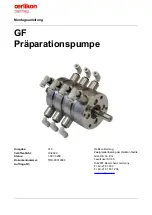
Servicing
Diaphragm Vacuum Pumps UN86_.16I
10
The item numbers in the following instructions refer to figs. 2 to 4.
Proceed as follows:
a) Preparatory step
1. Disconnect the pump from the power supply; check that the
pump is electrically dead and secure this.
b) Removing pump head
1. Mark the position of carrier (
1
), intermediate plate (
3
), and
head plate (
4
) relative to each other by a drawing line (
M
) with
a felt-tip marker. This is to ensure that the parts will be
reassembled in correct position at a later stage.
2. Release the nuts (
6
) and remove them together with the disk
springs (
5
).
The disk springs are fitted in order to maintain the tension of
the wave diaphragm right across the temperature range of the
pump.
3. Remove head plate (
4
).
4. Remove O-ring (
10
) from head plate (
4
).
5. Remove the valve plate (
11
) and the intermediate plate (
3
).
c) Changing diaphragm
1. Release the retainer plate (
7
) by turning it anti-clockwise with a
pin wrench or a wrench for retainer plate. While doing so, hold
the connecting rod extension (
9
) in place with holding tool.
Take care to ensure that the washer (
12
) does not slip under
the diaphragm support (
8
)
2. Remove wave diaphragm (
2
).
3. Check that all parts are free from dirt and clean them if
necessary (see section
6. Cleaning
).
4. Slide a new wave diaphragm (
2
) onto the threaded bolt of the
retainer plate (
7
).
The wave diaphragm assembly consists of two equivalent
parts placed on top of one another; the top and bottom are
identical.
5. Apply a small amount of heat-resistant thread adhesive (e.g.,
DELO ML 5327) to the thread of the retainer plate (
7
).
6. Screw the retainer plate (
7
) with wave diaphragm (
2
) into the
connecting rod extension (
9
); to tighten the retainer plate, use
the wrench for retainer plate/the pin wrench to turn it clockwise
(torque: 4.6 Nm). While doing so, hold the connecting rod
extension (
9
) in place with the holding tool; and hold the wave
diaphragms so that they do not twist.


































